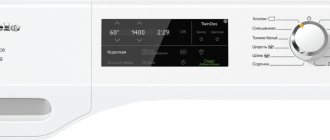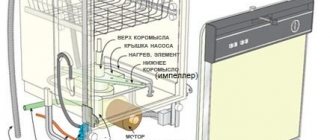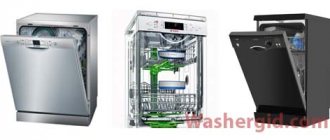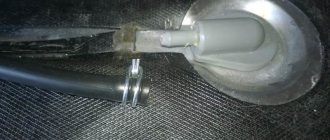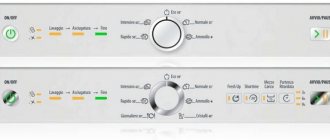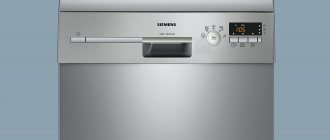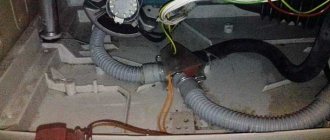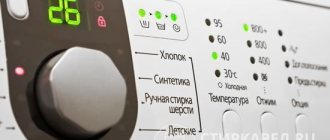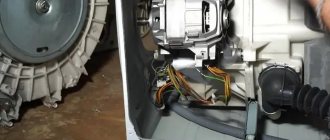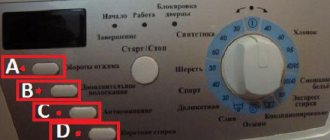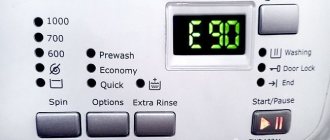The dishwasher fault indication will help you understand at what stage of operation the malfunction occurred or why this or that function does not work. Error codes are shown on the display. They are designed to guide the user on how to behave in various situations. Do not forget the golden rule - if you are not confident in your abilities, contact the service center. Professionals will definitely provide qualified assistance.
What types of malfunctions occur?
Any equipment must be properly maintained and the prescribed rules of use must be followed. Then you will encounter problems less often or avoid them altogether. But if symbols and numbers appear on the dishwasher display, this means that the device is telling you about a problem.
There are several types of error codes:
- technical;
- associated with the water supply or drainage system;
- general, responsible for the operation of the device;
- noises;
- unsatisfactory washing result.
You can eliminate most interference yourself.
Below we look at the most common error codes:
How to solve the problem - a detailed overview of the codes
If malfunctions of Miele dishwashers are detected, displayed using one or another code, then it is worth eliminating them as quickly as possible so that the device continues to function correctly. The method for solving the problem is selected depending on which code appears on the display, and if we talk in more detail about each of them, then you need to eliminate errors like this:
- appearance of F01 - diagnostics of the NTC sensor and its connections, if necessary, replacement of the part;
- code F02 – checking the temperature control sensor, repairing or completely replacing the part;
- error F11 - checking the pump and removing from it all foreign objects that have gotten there, replacing the relay or pump, checking the contacts and coils of the dishwasher relay;
- problem with code indicator F12 - check the flow meter wires, replace the sensor if necessary;
- code F13 - clean the filter, replace it if necessary, check the water pressure, if necessary, replace the sensor responsible for fluid flow;
- failure indicator F14 - replace the flow meter or remove valve blockage;
- error F15 – check before connecting the device;
- problem F18 - remove the blockage in the valve or completely replace it;
- code value F19 – check the performance of the water flow sensor, if necessary, replace it with a new one;
- indicator F24 - check the serviceability of the relay contacts, and also see if the amount of cleaning chemicals exceeds the norm, replace the relay or wiring;
- code error F25 - check the solenoid or replace the heating element, as well as the electronics;
- problem F26 - diagnose and replace the temperature sensor, if necessary;
- fault F32 - check the door serviceability parameters and perform the required repair of the module;
- error F33 - check the door opening mechanism and repair it;
- code indicator F40 - replace with a new electronic module;
- indicator F42 – check for problems with the power supply and carry out their proper elimination;
- problem F47 - check the quality of functioning of the sockets and the power supply network as a whole;
- code error F51 - check the wires and connections of the relay, perform a quality replacement if necessary;
- dishwasher malfunction F52 - remove the blockage, replace the pump or relay;
- error F53 - check the functionality of the sensor responsible for speed and replace it.
If F63 appears on the dishwasher display, then you need to check the control module. A qualified technician knows exactly what to do when an error code F67 is detected, and the user only needs to understand that, most likely, the circulation motor will need to be replaced and it is worth doing it.
If the owner of a dishwasher sees code F68 on its screen, this indicates the need to repair the circular pump. Coding F69 indicates the need to remove foreign objects from the pump to completely clean it. A malfunction of the F70 dishwasher indicates the need to check the tray, level it, and also indicate the need to dry electrical components. A qualified technician knows how to fix dishwasher errors, so you should definitely contact him for help.
Dishwasher error code F86 indicates to the user that it is time to check the salt container. If during the diagnostics it turns out that the part is broken, then it is worth inviting a qualified specialist to carry out repair work. The problem coded F87 requires replacing the sensor that softens the water. If the owner of the dishwasher encounters a fault F88, then you need to check the water purity control sensor, diagnose the condition of the wires of the specified part, and perform repair or replacement. The display of error code F91 indicates the need for competent diagnostics of the functioning of the dishwasher, and also indicates the need to activate the function that regulates the load factor.
How to fix error F14?
This coding indicates a malfunction in the water supply system. The supply has stopped because the heater relay is faulty. Here are several reasons for the error and tips on how to eliminate it.
Problem: Relay is faulty.
How to fix: first check the relay, then the power and wires. Connect power supply or replace parts.
Problem: The pump has failed.
How to fix: You need to make sure that there are no foreign objects stuck in the pump or condenser. You may need to replace parts.
Problem: the circulation pump winding is overheated and its fuse is not working.
How to fix: The pump needs replacement.
Typical malfunctions and error codes of PMM "Mile"
Service center technicians can confirm that Miele appliances are reliable. Moreover, the manufacturer provides a guarantee on individual components of the machine: engine, pump. Why then does the device fail and not work? Foreign assembly is not particularly designed for the realities of operating in our latitudes. Here are the main problems:
- Constant network outages that cause damage to electronics.
- Hard water with large amounts of salts. They settle as scale on parts.
To this we can add operational problems:
- Incorrect installation and connection of the PMM.
- Incorrect loading of dishes, overload.
- Using low-quality detergents.
When a problem occurs, a diagnostic is triggered, which is triggered by the electronic control of the PMM. After testing all nodes, an error code is displayed on the display, which informs about the causes of the problem. The most common:
- F11 - water does not drain from the tank.
- F12/F13 - water does not enter the bunker.
- F24/F25 - heating problems.
- F32/F33 - problems with the door lock.
- F40–F47 - problems with electronics.
- F70 - leakage, activation of the Aquastop protection.
Here are the problems that users most often complain about:
- The dishwasher is leaking.
- The equipment does not turn on.
- Water does not fill up.
- The door lock does not work.
- Heating does not work.
- Dishes are difficult to wash.
These are the main causes of problems. If you're ready to fix your appliances yourself, then read our guide below.
Error F70 and its elimination
Coding F70 reports a float switch error. The program is interrupted because the leakage protection system has activated. The drain pump has started working. The device will beep until you detect a problem. Please note that the drain pump continues to pump water even after the unit is turned off. To deactivate it, you must turn off the power supply.
Problem: There is water in the tray.
How to fix: you need to remove it with a cloth. Make sure that the tray is free of dirt and deposits. Next, check all hoses and connections, as well as the float switch. Dry all parts, especially electronics.
Problem: The float is faulty.
How to fix: Replace it.
Problem: the tray is deformed.
How to fix: Pull it out and try to straighten it.
Error codes in Miele dishwashers
Various errors are shown on the display in alphanumeric format. Depending on the model of the machine, additional LED indication and a sound signal may be activated. For example, for embedded technology, all indicators on the program control panel blink and an error code is displayed on the screen.
The most common types of errors occur:
- Error f0 is a system notification that no errors were detected during diagnostics.
- Error f1 – short circuit of the NTC temperature sensor or its connecting wires. The equipment does not heat the water and does not start rinsing.
- Error f11 - a clogged drain pump prevents water from draining. The circulation pump operates for 2 seconds after each drain cycle. The sensor monitors the water level, increasing the drainage time when it is exceeded. The operation of the equipment stops if additional diagnostics reveal a pumping violation and an excessive amount of water. The cause may be a bend in the drain hose, a clogged drain, or a problem with the drain block.
- Error f13 - water supply is intermittent. The controller registers fewer pulses from the flow meter than necessary. If this happens within 4 minutes, the cycle is interrupted. The drainage pump comes into operation. The malfunction may be due to poor water supply or a breakdown of the heater pressure switch.
- Error f14 – water supply stops. An error is logged when a problem is detected with the heater pressure switch. The cavity of the circulation pump is probably clogged. The self-diagnosis system checks the relay after a water supply cycle. If there is no signal from the switch, operation is interrupted.
- Error f24 - lack of heating due to an electronics malfunction. Most likely, this is due to the heating element relay, which is responsible for the operation of the heater: wire damage, contact oxidation, short circuit, board failure.
- Error f70 - water leakage, as a result of which the float switch in the pan is activated. The system for protecting equipment against leaks is activated. It is necessary to check the tightness of all elements and the level of the tray. If the drain pump is leaking, it must be replaced. The error sometimes occurs after replacing the electrical control module, then it can be easily resolved by restarting the system.
- Error f78 - problems with the circulation pump: clogging, failure of the controller or frequency converter, insufficient supply voltage.
Errors PMM "Miele" without display
Models: G1022, G1143, G1162, G1171, G1173, G1202, G2143, G4170, G4570.
| Indicators. | Code and description. | Cause and solution. |
Several indicators flash simultaneously (their set depends on the model):
|
|
|
| The Fill/Drain indicator flashes and lights alternately. | No water supply. | See F12 - F19 . |
| The Fill/Drain indicator is flashing. |
|
|
Advantages of Miele washing machines
The German company produces fully built-in and freestanding models with both front and vertical loading. There is a whole line of professional equipment intended for commercial use in laundries, medical institutions, sports clubs, restaurants, hotels, beauty salons, and universities. Premium-class equipment from Miele is distinguished by impeccable design, reliability and support for a large number of intelligent options. Even the most demanding client will be able to choose the ideal option for himself.
All washing machines are assembled in Germany from durable and environmentally friendly materials. Innovations, which are patented Miele technologies, are actively introduced at all stages of production. Before going on sale, devices undergo multi-level testing, which confirms the standard quality of the equipment. All top-loading models are equipped with a mobile frame and support automatic drum parking.
The unique honeycomb drum in Miele washing machines has a network-like structure. This design effectively prevents the appearance of pills and puffs on clothes, and also prevents small objects from getting into the drain system. When rotating, a thin film of water is created between the laundry and the metal surface of the drum, guaranteeing perfect protection of the fabric.
Start drying
Many models are equipped with turbo dryers. The heating element heats the air, and a special fan disperses it throughout the chamber. If you have such a function installed, then it's worth checking:
- Drying heating element.
- Fan.
- Wiring.
For repairs, it is better to contact a specialist, because replacing the fan requires complete disassembly of the case.
If your model comes with condensation drying, try replacing the rinse aid. Sometimes drops of moisture remain on the surface because there is not enough time to dry.
We bring back quality washing
The quality of contaminant removal is influenced by many factors, ranging from operational errors to component failures. White streaks on the surface of dishes occur from a lack of rinse aid or salt. The latter reduces water hardness.
Make sure the quality of the detergent. Replace it or increase the dosage.
Check the parts inside the chamber for blockages:
- Spray nozzles. Water flies out through these holes under pressure. They become clogged with small debris and pieces of food. You can clean them with a toothpick.
- Drain path. Remove debris from the filter. Check the impeller. It may be blocked by foreign objects, then the pump does not drain the liquid.
The quality of washing is affected by heat. How to solve this problem is described above. It is also worth checking the circulation pump. It pumps liquid under pressure into the sprinklers. The faulty motor must be replaced. It is also located under the bottom of the PMM.
- Release the fastenings of the clamps and remove the pipes from their place.
- Disconnect the wiring plugs.
- Remove the motor from the housing.
For replacement, choose only original parts for the Mile model.
Explanation of error codes
F14
: water supply error.
Really
: for Miele dishwashers.
Explanation
: Error in the water supply system. The water supply has been interrupted because the heater pressure switch has been detected to be faulty. There may be foreign bodies or blockages inside the circulation pump.
When the circulation pump is running after the water inlet stage, the heater pressure switch is checked to ensure sufficient water pressure in the wash water circuit. To do this, the heater relay must be activated. If no information is received from the switch, the program is interrupted and the drain pump runs. The display shows error message “F14”. The sound signal (buzzer) is activated for 2 minutes.
Elimination
: Contact Miele Service.
Please note that the error code does not usually indicate which component needs to be replaced. Error codes serve only as a guide for the service engineer in which direction to look for a problem.
For example, if the error description says “does not heat up” does not mean that the heater needs to be replaced! There are many other possible reasons why this message may appear.
All information provided is a guide only and requires expert knowledge. If you have no experience in electrical repairs, you need to contact a Miele service center.
Source
DIY Miele dishwasher repair
Nowadays it is not difficult to find a service center that will repair the Mile dishwasher. But some problems can be fixed with your own hands.
Fixing the leak
The machine received full protection against leaks. It is equipped with full Waterproof protection, which in principle does not differ from the Aquastop system we know. The inlet hose is equipped with a safety valve. During a leak, it blocks the flow of water.
A float sensor is located in the PMM pan. If water gets into the pan, the float floats up, triggers the sensor and the operation of the machine is blocked. Then an error code is displayed on the display.
Why then does the car leak?
- It's a matter of design. Despite the high-quality assembly and high cost of the device, the tray is often made of plastic. It could crack during transportation or use. Why does a leak occur under the housing?
Important point! After delivering the equipment to your home, carefully inspect its body and all components. If you immediately notice a broken pan, the machine can be replaced.
If you notice the problem later, it will be difficult to prove anything. Therefore, you will have to change the element yourself.
- Incorrect connection. It is possible that when connecting the hose, the thread slipped out or the gasket was compressed. Check connections.
- Damaged door gasket. Press the door tighter. If it doesn't work, inspect the gasket. Over time, it wears out and gets crushed. Replace it with a new one.
Let's launch the equipment
After turning on the device, the indicators on the panel do not light up and the program does not start. Although the PMM is connected to the network and the start button is pressed.
Carry out an inspection:
- Electrical cable and plug. Any damage to the insulation, scorching, or melting should lead to a complete replacement of the elements. The equipment cannot be used in this condition.
- Sockets. Remember, powerful appliances must be connected to a separate grounded outlet. If burn marks are noticeable, contact an electrician for replacement.
You also need to inspect the contacts of the On/Off button. For this:
- Disconnect the PMM from the network.
- Open the door.
- Unscrew the screws securing the inner part.
- Disassemble the two parts of the door and remove the board.
- Inspect the button contacts. They can be cleaned, if this does not help, then the button needs to be replaced.
When replacing the button contacts, you will have to solder them. Leave this repair to a professional. If the board is damaged, it will be more profitable to buy a new machine.
Causes
Failure to drain water often indicates a clogged drain system. Over the years of operation, small debris can accumulate in the hose, pipe and drain filter: human hair, pet hair, lint from clothing, scale, and the like. Due to clogging, at one point the machine will not be able to drain the water, or will do so very slowly.
Another common cause is a malfunction of the drain pump (pump). This part contains an electric motor, which can burn out due to many factors. The pump impeller is damaged due to material fatigue or small objects getting into it. A broken pump needs repair or replacement.
According to statistics, problems with electronics are less likely to cause error F11, but in some cases this code may appear due to burnt out wiring, triacs, or a glitch in the control unit. The lack of a signal from the pressure switch also sometimes leads to the machine freezing. The electronics simply “does not see” the water level in the tank, so it does not drain.
Miele dishwasher repair
Miele dishwashers are manufactured by the German company Miele & Cie of the same name. KG. The history of Miele dates back to 1899. In 1929, Europe's first dishwasher was developed and manufactured. Since the founding of the company, the slogan “Immer Besser” has been formed, translated as “Everything is better, better,” which is known all over the world.
Miele dishwashers belong to the premium class; it is the only brand of household appliances whose products are represented on five continents of the globe. In 1960, the first fully automatic dishwasher was released. And in 1978, Miele began producing dishwashers with a microprocessor and touch control panel.
Even a machine from a reputable manufacturer can malfunction or break down!
Don't delay with repairs!
A dishwasher is an integral system, where incorrect operation or damage to one unit or part entails a consistent disruption in the operation of other components.
Prompt and high-quality work carried out by a professional technician will guarantee the serviceability of your dishwasher for many years!
We offer:
- Departure throughout Moscow at a time convenient for you;
- Most faults are eliminated during one visit of the specialist;
- Discussion of the cost of possible repair options;
- Original spare parts from the manufacturer, as well as assistance in selecting analogues;
- Affordable prices for repairs (See table);
- We tell and show what we do;
- Consultations on the correct operation of the machine;
- We draw up a receipt with a contract, a work acceptance certificate and a guarantee (Strict reporting form), which will indicate your data, the brand and model of the dishwasher, the work performed and the warranty period.
Possible variants of the malfunction, the estimated cost of repair and time can be found out from the specialist, but it should be noted that even the best specialist cannot make over the phone
Repair prices
| Type of work | Cost of the master’s work*, rub. | Warranty period, months |
| Expert visit, fault diagnosis | 1 000* | — |
| Dismantling and installation of a built-in dishwasher | 1 300 | — |
| Simple repair | ||
| Cleaning the filler filter | 1 800 | — |
| Cleaning filters | 2 300 | — |
| Cleaning the spray arm (one) | 1 800 | 6 months |
| Adjusting and cleaning the water level switch | 2 300 | 3 months |
| Replacing the network cable | 2 200 | 1 year |
| Replacing the inlet hose | 1 800 | 1 year |
| Replacing the drain hose | 2 700 | from 1 to 2 years |
| Replacing the inlet hose with Aquastop | 2 300 | 1 year |
| Replacing a button | 1 800 | 6 months |
| Repair or replacement of wheels (holders) of the basket (one) | 200 | 6 months |
| Repair or replacement of door springs (one) | 2 500 | 6 months |
| Lock mechanism repair | 2 500 | 1 year |
| Repair or replacement of door hinge (one) | 2 200 | 6 months |
| Replacing the sprinkler (one) | 1 600 | 3 months |
| Replacing the lower door seal | 2 200 | 6 months |
| Replacing the U-shaped seal | 3 200 | 6 months |
| Repairing or replacing the detergent dispenser | 2 500 | 1 year |
| Replacing the salt sensor | 2 300 | 3 months |
| Replacing the control sensor | 2 300 | 6 months |
| Medium renovation | ||
| Finding and clearing blockages in the drain system | 2 700 | — |
| Unlocking the circulation pump | 3 600 | — |
| Repair or replacement of pipe | 3 200 | 1 year |
| Heat exchanger repair | 4 100 | 6 months |
| Repair of the washing tank glass (repair kit) | 3 200 | 1 year |
| Electrical wiring repair | 2 700 | 2 years |
| Repair or replacement of the Aquastop leak protection system | 3 600 | 1 year |
| Replacing the heating element | 3 400 | 6 months |
| Replacing the flow-through heating element | 4 000 | 1 year |
| Replacing the thermostat or temperature sensor | 3 100 | 6 months |
| Replacing the starting capacitor of the circulation pump | 2 900 | 1 year |
| Replacing the turbidity sensor | 3 800 | 6 months |
| Replacing the salt tank | 3 800 | 1 year |
| Replacing the water flow sensor | 3 200 | 6 months |
| Replacing the door lock device | 3 200 | 1 year |
| Replacing the water level sensor | 3 100 | 6 months |
| Replacing the fill valve | 2 900 | 6 months |
| Repair or replacement of the circulation pump | 4 300 | 3 months |
| Replacing the drain pump | 3 100 | 6 months |
| Replacing the control board (indication) | 4 100 | 1 year |
| Repair of control board (indication) | from 4 900 | 6 months |
| Replacing the control panel | 2 900 | 2 years |
| Complex repair | ||
| Replacing the sump cup of the circulation pump | 6 300 | 1 year |
| Replacing the water inlet | 4 500 | 1 year |
| Replacing the washing tank | 6 300 | 1 year |
| * The indicated prices are for repair work (excluding the cost of spare parts and components), spare parts and components are paid additionally. * There are no free services, a technician’s visit and diagnostics cost RUB 1,000. If you agree to repair, there is no charge for travel and diagnostics. False call, payment 1000 rub. The final cost of repairs depends on the complexity of the work and the cost of spare parts, components and materials. | ||
Call, write to us, and we will always be happy to help!
Consultations and requests for repairs are accepted daily, from 8 a.m. to 10 p.m. by phone
8 (985) 181 – 02 – 88
8 (985) 181 – 02 – 88 (Whatsapp)
or using an online application.
Leave a request for repairs
Quick online diagnostics of dishwasher faults (Simply select a problem from the list and find out the approximate breakdown)
Miele dishwashers have the function of displaying an error code when certain malfunctions and malfunctions occur. Quite often, understanding what the error code means , you are able or breakdown yourself
For your convenience, a list of error codes for Miele dishwashers is provided with an explanation of each specific code . The table also includes a description of the error, the reasons for its occurrence and possible solutions.
Decoding Miele dishwasher error codes
To more accurately determine the cause of the malfunction, especially on models without a display, there is a test mode, which is launched by a special key combination.
| Error code | Description of the error | Causes and elimination |
| F01 | No water heating due to problems with the temperature sensor (NTC) | If an error is detected, the heating and rinsing functions are blocked, after the end of the program an error code is displayed and within 2 minutes. sound signal. Short circuit of the NTC temperature sensor (R30) or its connection. 1. Check the temperature sensor for a break; at 20°C the resistance should be approximately 14.9 kOhm (± 750 Ohm), at 25°C approximately 12 kOhm (± 600 Ohm). 2. Replacing the temperature sensor. |
| F02 | Water does not heat up due to lack of signal in the temperature sensor circuit (NTC) | The heating and rinsing stages are skipped, after the end of the program an error code is displayed and for 2 minutes. a beep sounds. 1. Broken wiring in the sensor circuit. 2. The contacts at the sensor or the connectors on the control controller have come loose. 3. Sensor malfunction. 4. Failure in the control module. |
| F11 | Water does not drain well from the bunker. | Drain fault. When draining, after each step of the drainage pump (the circulation pump runs for 2 seconds and the heating relay B1/13 checks the water level), the sensor checks the water level: if it does not correspond to what is expected, the program first increases the drainage time; if the water level continues to remain abnormally high, the program ends early. In addition to the error code within 2 minutes. a beep sounds. 1. Defect or clog in the drain hose. 2. There is a blockage in the pan or the pan is stuck (non-return valve malfunction) 3. The drain filter is clogged. 4. Incorrect drain connection. 5. Blockage in the drain pump. 6. Open circuit in the power supply circuit of the pump or level sensor (pressostat) 7. Malfunction of the pressure switch. 8. Control module failure. |
| F12 | Water did not begin to flow into the tank within the required period of time. | Water intake fault At the beginning of any stage with water intake from the flow meter, a certain number of signals must be sent to the electronic controller; if this does not happen, an error is displayed, the remaining functions of the device are blocked and the drain pump is turned on to prevent possible flooding of the machine, every 10 sec. Several more attempts will be made to start the water supply, if unsuccessful for 2 minutes. The sound signal turns on. 1. Water does not enter the machine at all. 2. The door is not tightly closed. 3. The flow meter (water flow sensor) does not work. 4. The inlet solenoid valve is broken. 5. The water level sensor (pressostat) is faulty 6. There is a break in the wiring or the contacts in the circuits have come loose from the control controller to the inlet valve, flow meter or pressure switch. 7. Management controller failure. |
| F13 | Problems with water collection, the tank does not fill in the required period of time. | Water intake fault. The program was interrupted, the drain pump runs after 2-4 minutes. a two-minute beep will sound. This error occurs when the required number of signals (this varies depending on the program) has not been registered within 4 minutes. If the selected program starts with a rinsing cycle, the error message is displayed more quickly. In the event of an error, the selected program is interrupted after approximately 30 seconds. 1. Problems with water supply. 2. The water supply valve is faulty. 3. Check the leakage protection system, valve Y2 (filter and restrictor). 4. Check the reed switch connection. 5. Check the Y2 valve filter in the leakage protection system. |
| F14 | Water supply interrupted due to faulty heater pressure switch. | Technical code. If no information is received from the switch, the washing program is interrupted, the drain pump is turned on and an audible signal sounds. With the circulation pump running, after drawing water, the heater relay should be checked to ensure that the system has the required water pressure. The heater relay must be activated. 1. Heater pressure switch B1/13 is faulty. 2. The circulation pump has failed, the circulation pressure is too low (no pressure at the relay switch), the pump may be clogged. 3. Foreign objects in the pressure switch. 4. Flow meter B3/4 is faulty (indicates the wrong amount of water). 5. The circulation pump is faulty. 6. After drawing water, heating element pressure switch B1/13 skipped steps 11-12 and 21-22, the anti-stick system starts. Pressure switch faulty. 7. Motor capacitor is faulty. 8. Replace the heater wiring harness. |
| F15 | The water entering the machine is too hot. | The temperature of the water being filled is too high. 1. Error connecting water to the machine; hot water is supplied instead of cold. 2. If, when connecting to a hot water supply, you are unable to somehow control the temperature of the water poured into the machine, you can connect it to cold water. 3. The temperature sensor is faulty. |
| F18 | Unplanned entry of water into the machine. | Technical code. If signals are received from the water flow sensor at a time when water intake is not provided for by the current stage of the washing program, it is interrupted and the drain pump is immediately turned on. 1. Fill valve malfunction. 2. Open circuit in the fill valve or pressure switch. 3. The pressure switch is faulty. 4. Failure in the control module. |
| F19 | The water intake is interrupted due to the fact that the flow meter impeller rotates tightly. | Technical code. The washing is immediately interrupted and the drain pump is turned on, an error is displayed and an audible alarm sounds for 2 minutes. Flow meter malfunction, check using a specific testing program. |
| F24 | No heating due to problems with the heater relay. | Technical code. Malfunction of the heating element relay that controls the operation of the heater. The program has been interrupted, the drain pump is running, the sound signal lasts 2 minutes. 1. Broken wires, loose or melted contact in the heating element circuit. 2. Moisture got into the relay, causing the contacts to oxidize or a short circuit to occur. 3. The heating element relay on the electronic board has failed. Contamination of the heater wiring harness plug results in a resistance value between the contact blades of 10 MΩ. Heater relay resistance B1/13 (pins 12 and 22 on plug 5), if the measured resistance is less than 10 MΩ, then the heating element wiring must be replaced. |
| F25 | The water does not heat up to the specified temperature in the required time. | Technical code. If the water has not warmed up in 75 minutes; the program is not interrupted, the error is reported after the wash is completed and an audible signal sounds. After such an error, all subsequent washes are carried out without heating and the rinse aid is not distributed. 1. One of the sensors is faulty - a temperature sensor (thermistor) or a water level sensor (pressostat) 2. Too much water has been poured into the tank (for example, due to a faulty level sensor) 3. An open circuit in the heating element control circuit. 4. Short circuit in the heating element circuit, leakage to the housing. 5. The heating element burned out. 6. Problems with the control controller. |
| F26 | The water in the tank is too hot. | Technical code. The boil protection is turned on if the water temperature has reached 90 °C, the washing is interrupted, the drain pump starts working, an error is displayed and for 2 minutes. a beep sounds. 1. The NTC temperature sensor shows inaccurate values. 2. The heater relay does not work (closed), which does not allow the heating element to be controlled. |
| F32 | There is no signal to close the door. | Washer won't start. 1. Lost connection between the door sensor control triac and the control controller. 2. Malfunction in the door lock. 3. The door closing sensor is faulty. 4. Problems in the control controller. |
| F33 | The door cannot be opened due to problems with the door lock. | Washer won't start. 1. Lost connection between the door sensor control triac and the control controller. 2. Malfunction in the door lock. 3. The door closing sensor is faulty. 4. Problems in the control controller. |
| F36 | Problems with closing or opening the door due to a faulty door closing sensor. | There is a break in the sensor control circuit or the sensor itself is broken. |
| F40 | Control module error. | Technical code. The washing process is interrupted, the drain pump is turned on, an error code is displayed and an audible signal sounds. 1. Check the voltage in the electrical network. 2. Check the wiring leading to the electronic boards for breaks or short circuits. 3. Control module malfunction. |
| F42 | The mains voltage does not meet the standard. | Technical code. The voltage differs from the standard by more than 5 Hz. The washing program is interrupted and the drain pump starts working, an error code is displayed and a sound signal sounds. Damage to the main power supply. |
| F47 | Power problems have been detected. | |
| F51 | Heater relay is faulty. | Technical code. The washing process ends, the drain pump turns on, and the sound signal lasts 2 minutes. 1. Broken wires, loose or melted contact in the heating element circuit. 2. Moisture got into the relay, causing the contacts to oxidize or a short circuit to occur. 3. The heating element relay on the electronic board has failed. Contamination of the heater wiring harness plug results in a resistance value between the contact blades of 10 MΩ. Heater relay resistance B1/13 (pins 12 and 22 on plug 5), if the measured resistance is less than 10 MΩ, then the heating element wiring must be replaced. |
| F52 | The pressure switch turned off the heating element during heating. | The washing continues, but without heating. The error is only displayed when running a diagnostic test. 1. Too much foam is formed due to an excess of detergent or rinse aid, after washing in the tank there are traces of foam on the walls of the hopper or dishes. 2. Heater pressure switch is faulty. 3. The circulation pump is faulty or incorrectly positioned, causing its pressure to be too low. 4. The circular pump is clogged, there is dirt on its blades. 5. Malfunction in the control module. |
| F53 | Faulty motor speed sensor (tachometer) | Check the wiring and contacts, the sensor itself and the control controller. |
| F63 | The door lock is faulty. | Washer won't start. 1. Lost connection between the door sensor control triac and the control controller. 2. Malfunction in the door lock. 3. The door closing sensor is faulty. 4. Problems in the control controller. |
| F67 | The rotation speed of the circulation pump is too low or, conversely, high. | |
| F68 | The circulation pump does not turn off. | |
| F69 | The circulation pump does not rotate. | The program was interrupted, but the drain pump is running. The error will be shown on the display or via an indicator. The beep lasts 2 minutes. With the circulation pump running, the heater pressure switch contacts are isolated. To do this, the heater relay must be turned on and the electronics connectors must be free. 1. Malfunction of the heater pressure switch. 2. The circulation pump is clogged with debris or a lot of dirt has accumulated on its blades. 3. The pump is blocked by something, perhaps by poorly placed dishes. |
| F70 | Water leakage from the tank, overflow, leak. | A signal was received from the float sensor of the Aqua-Stop leak control system, which indicates the appearance of water in the sump. The washer stops and the drain pump starts, an error is displayed, and the beep continues until a problem is detected. Considering the possible consequences, the drain pump continues to work even after turning off the machine; it can only be stopped by turning off the power supply. 1. Water leaks into the pan, you need to turn off the water and carefully inspect all places where there may be a leak, make sure that they are sealed, the housing, hoses and their connections. 2. Check the level of the tray; it should be horizontal. 3. The drain pump is leaking. 4. The float sensor for monitoring water leakage is faulty or there is a short circuit in its circuit. 5. The error may appear after replacing the electronic control module; in this case, restarting the machine helps. |
| F78 | There is a problem with the circulation pump. | |
| F84 | The door lock is faulty. | |
| F85 | Incorrect signal from the door shutter. | |
| F86 | There is no signal from the salt container lid sensor. | Replacing the sensor. |
| F87 | The water softener sensor is not working. | A faulty sensor must be replaced. |
| F88 | The water turbidity sensor is faulty. | If this error is detected, the program does not stop. The error will be indicated when the memory is checked in service mode. If this error is detected, the program continues with default settings. 1. Clean the dishwasher compartment. 2. Open circuit in the sensor circuit. 3. The sensor itself is faulty. 4. Problems with the control controller. |
| F91 | Load volume control is inactive. | The function is inactive. |
| For Miele models G1220, G1222, G1225, G1232, G1235, G1262, G1270, G1272, G1275, G1330, G1343, G1344, G1383, G1384, G1470, G1502, G1522, G1532, G2173, G2222, G2225, G2232, G2235, G2272 , G2275, G2344, G2383, G2384, G2522, G2532, G4202, G4203, G4207, G4208, G4210, G4212, G4215, G4217, G4263, G4268, G4280, G4285, G4292, G4297, G4 600, G4670, G5100, G5105. | ||
| F70 FXX Several LEDs flash simultaneously 1. “Wash”, “Drying”, “Program completed” 2. “Wash”, “Drying”, “End” 3. “Wash”, “Drying” 4. “Wash”, “Rinse aid” » 5. “Wash”, “Salt” 6. LEDs for all programs Error code FXX (technical fault) is displayed | Leakage, technical fault (FXX) | A signal was received from the float sensor of the Aqua-Stop leak control system, which indicates the appearance of water in the sump. The washer stops and the drain pump starts, an error is displayed, and the beep continues until a problem is detected. Considering the possible consequences, the drain pump continues to work even after turning off the machine; it can only be stopped by turning off the power supply. 1. Water leaks into the pan, you need to turn off the water and carefully inspect all places where there may be a leak, make sure that they are sealed, the housing, hoses and their connections. 2. Check the level of the tray; it should be horizontal. 3. The drain pump is leaking. 4. The float sensor for monitoring water leakage is faulty or there is a short circuit in its circuit. 5. The error may appear after replacing the electronic control module; in this case, restarting the machine helps. |
| The Fill/Drain LED flashes and lights alternately. | No water supply. | See above for the description of errors “F12” - “F19” |
| F12, F13 F11 The Fill/Drain LED flashes, error code FXX is displayed. | Problems with water supply (F12/F13). Problems with draining water (F11) | See description of errors “F12” and “F13” See description of error “F11” |
| For models without display Miele G1022, G1143, G1162, G1171, G1173, G1202, G2143, G2222, G4170, G4570 | ||
| Several LEDs flash simultaneously. 1. “Wash”, “Dry”, “Finish”. 2. LEDs for all programs. | Leak. Technical malfunction. | A signal was received from the float sensor of the Aqua-Stop leak control system, which indicates the appearance of water in the sump. The washer stops and the drain pump starts, an error is displayed, and the beep continues until a problem is detected. Considering the possible consequences, the drain pump continues to work even after turning off the machine; it can only be stopped by turning off the power supply. 1. Water leaks into the pan, you need to turn off the water and carefully inspect all places where there may be a leak, make sure that they are sealed, the housing, hoses and their connections. 2. Check the level of the tray; it should be horizontal. 3. The drain pump is leaking. 4. The float sensor for monitoring water leakage is faulty or there is a short circuit in its circuit. 5. The error may appear after replacing the electronic control module; in this case, restarting the machine helps. To determine the cause, a service test must be performed. |
| The Fill/Drain LED flashes and lights alternately. | No water supply. | See description of errors “F12” - “F19” |
| The Fill/Drain LED flashes. | Problems with water supply. Problems with draining water. | See description of errors “F12” and “F13” See description of error “F11” |
A dishwasher consists of units that are complex in design, and if they break down, it is better not to try to repair them yourself unless you have previously repaired dishwashers yourself and are not familiar with safety precautions when repairing electrical equipment. Moreover, this is due to high voltage and the possibility of flooding neighbors living on the floor, or even two or three floors below, and unnecessary financial expenses.
When carrying out repairs yourself, remember your safety!
Disassemble without disconnecting the equipment from the mains!
It is best to use the services of an experienced technician who is familiar with any problems and can fix the problem. If your dishwasher breaks down, entrust the repair to a professional: he will be able to perform all the steps quickly, efficiently and safely.
How to call a specialist?
Requests for repairs are accepted daily, from 8 am to 10 pm by phone or using an online application.
8 (985) 181 – 02 – 88
8 (985) 181 – 02 – 88 (Whatsapp)
Leave a request for repairs
Important! When contacting, please provide the following information: Your contact information: name, phone number and address, make of the machine, if possible, send a tag with the serial number and product code of the machine and the day and time of arrival of the technician that suits you.
To carry out repairs and select spare parts for a dishwasher, you need to know its model and serial number.
The exact model of the machine is indicated on the tag on the dishwasher body or stickers, as well as in the operating instructions. If you have already purchased replacement parts yourself, please indicate only the make of the machine. For example, MIELE G 7965 SCVi XXL.
places where dishwashers may contain a sticker with all the necessary service information.
1. Under the door on the body. Most often, on dishwashers, the serial number is located on a sticker under the door. Either on the door itself or on the body. In most cases, the number consists of numbers, less often of numbers and letters .
2. On the back wall. The back wall of the dishwasher is a traditional place for all kinds of service information. If you couldn’t find a sticker with a number on the front, then it was probably preserved on the back wall.
3. In the passport or instruction manual. Finally, the serial number can sometimes be found on the documents that come with the purchase of the dishwasher. As a rule, the number is located in the passport or warranty card.
The arrows show the location of the tags
Dishwasher manufacturers encode on the tag (sticker) what they produced, when, where and from what parts. This information is encoded in two sequences of numbers (letters) product and serial numbers. Their combination is unique and applies only to one specific dishwasher.
Please take a photo of these tags
To maximize the life of your dishwasher, you need to carefully read the operating instructions. If you have lost it, here you can select your model and download it in pdf format.
Miele dishwasher operating instructions
| MIELE G 391 | MIELE G 624 | MIELE G 898 |
| MIELE G 1022 | MIELE G 1173 (2173) | MIELE G 1225 (1235, 2225, 2235) |
| MIELE G 1470 | MIELE G 1572 (2572) | MIELE G 1833 (2833) |
| MIELE G 2830 | MIELE G 4212 | MIELE G 4600 |
| MIELE G 4911 | MIELE G 5100 (5105) | MIELE G 5980 (5985) |
| MIELE G 6160 | MIELE G 7855 | MIELE G 8050 (G 8051, PG 8052 SCi) |
| MIELE PG 8055 | MIELE PG 8057 TD | MIELE PG 8083 SCVi |
Dishwashers from manufacturers that we repair
Diagnostic features of this technique
By studying the fault codes of Miele dishwashers, technicians from certified service centers simultaneously understand a bunch of nuances associated with identifying breakdowns using these codes. You can fully understand what we are talking about only by having some experience in eliminating defects in these machines, but we will try to briefly explain what we mean using a specific example.
We will take error F01 as an example. It not only indicates a breakdown of the temperature sensor, as the transcript from the professional instructions states. This code may appear:
- if the supply wiring of the temperature sensor is broken;
- when the contacts connecting the wiring to the temperature sensor and the control module are oxidized;
Miele dishwashers use high-quality wiring and reliable contacts, but they are also subject to various negative influences, especially after a long period of time.
- if there is a physical breakdown of the control board (semiconductor elements or tracks burnt out);
- if problems arise with the firmware of the control module.
All these defects can accompany each error code, so they always need to be supplemented with the list of defects that the standard decoding offers us. You also need to take into account that the machine can issue not one, but two codes at a certain interval. Then you need to carefully study the decoding and understand how these codes are interconnected. Only in this case will it be possible to recognize the defect relatively quickly.
Description of codes F01 to F40
The self-diagnosis system of the Miele dishwasher contains 32 error codes in its database. This is a very detailed system that can respond to even minor problems. Let's try to describe it and at the same time talk about the faults to which these codes react.
F01. We have already mentioned this code in the first paragraph. It means the temperature sensor is defective. This code is displayed accompanied by a sound signal that lasts for 2 minutes. What to do? First, reload the dishwasher by turning off the power completely for 15 minutes. If the machine generates an error again, disconnect it from communications, remove the side wall and check the temperature sensor with an ohmmeter. The working part should produce 15 kOhm. If it is faulty, replace it.
F02. This error more specifically indicates a loss of communication between the temperature sensor and the control module, in other words, a broken wire. But failure of the sensor itself cannot be ruled out. In this case, we disassemble the machine in the same way, but first of all we check not the temperature sensor, but its wiring. If one of the wires is broken, it must be replaced.
F11. Indicates that the Miele dishwasher cannot drain waste water into the drain. The display may additionally display the message Drain fault. There are 4 most likely reasons:
- a blockage has formed in the siphon, drain hose, pump or pipe;
- a blockage has formed in the garbage filter;
- the pump has failed;
- The heater relay, which determines the pressure in the system, has burned out.
First of all, you need to check the garbage filter, then the siphon fitting, the siphon itself and the drain hose. The blockage may even end up in the sewer pipe, in which case you will need to call plumbers, not dishwasher repair specialists. Through the side of the housing we gain access to the pump and check it for blockages or malfunctions. Lastly, we test the heater relay and change it if necessary.
F12. This error eloquently tells us that there are problems with the flow of water into the Miele dishwasher. The code may be accompanied by the words Water intake fault. To get to the bottom of the reasons for this error, you must first check whether the cold water in the house has been turned off. If there is water in the water supply, but it flows in a slow trickle, this can also cause code F12. Is everything ok with the water supply? This means you need to remove and check the water flow sensor. You need to remove the hose and blow out its tube, check the resistance, check the wiring. Next you need to check the intake valve; if it is faulty, you need to change the part.
F13. This error is similar to the previous one, but it is more indicative of problems with the pressure switch. Other reasons why water does not flow into the machine can be considered additional, but they should not be discounted either. We proceed in exactly the same way as in the case of error F12, only we additionally check the intake valve filter for blockages.
F14. This code indicates a problem with the heating element pressure switch. If such an error occurs, you must first check the pressure switch with a multimeter, test its wiring, then check the flow meter and finally check the circulation pump. If one of these parts is faulty, it must be replaced.
F15. A rather unusual error that appears when hot water is supplied to the machine. This happens when, during unqualified installation of a dishwasher, the technician mixed up the inputs and supplied hot water to the machine instead of cold.
So, you can confuse the outputs if the goal was to connect the machine to hot water, but since the hot water hose was connected to the wrong output, the Miele machine generated error F15.
F18. The inlet valve is constantly open, and water gradually flows into the machine by gravity. At the same time, the drain pump tries to pump out excess water and works all the time. Most likely, the problem is a broken intake valve; it should be checked and replaced. In more rare cases, the fault of the control module is to blame; if so, you need to contact a specialist.
F19. This error tells us that the water flow sensor is faulty or blocked. Often this code appears when the sensor tube becomes clogged with debris and the problem can be solved by cleaning this tube. Maybe the sensor is simply burnt out and needs to be replaced. You need to remove it and check it with a multimeter, you also need to remember to test the wiring.
F24. This specific code appears when problems occur with the heating element relay. It is usually caused by a short circuit in this part, which could occur when water or foam gets in. In more rare cases, the code appears if the relay contacts are simply heavily oxidized. The problem can be solved by cleaning the contacts or replacing the part.
F25. The error indicates that the water heating rate in the system is insufficient, or that it is impossible to reach the temperature that was set by the program. How to fix this shortcoming? You need to check the temperature sensor, heating element, as well as the control module bus. There could also be a serious firmware glitch. In more rare cases, the error is caused by an excessive amount of powder. Most often, replacement of the heating element or temperature sensor is required.
F26. This error “pops up” on the display of the Miele dishwasher in an emergency, when the heating element tries to bring the temperature of the water in the system to a boil. A special sensor prevents this from happening. The reason is a malfunction of the temperature sensor, which takes incorrect measurements and sends incorrect information to the control module. The problem is solved by replacing the temperature sensor.
F32, F33. These codes indicate problems with the Miele dishwasher door locking device. These codes can be seen when the door either cannot be opened or, conversely, cannot be closed. To eliminate the door defect, the locking device is removed. Sometimes it can be fixed simply by cleaning or replacing the spring, but more often it requires replacement.
F36. This error indicates a problem with the door switch. This element should be checked with a multimeter and, if necessary, replaced.
F40. A rather terrible mistake in its consequences. It indicates very serious physical damage to the control board. In more rare cases, this failure can be eliminated by replacing the firmware, but more often it is necessary to change the entire control board. Both should be entrusted to the master.
Description of codes F42 to F91
F42, F47. Such errors appear when problems occur with the electrical network. Sensitive sensors in the Miele dishwasher detect fluctuations and stop the machine, issuing codes F42, F47. In this case, you need to turn off the machine and wait until the power grid restores normal operation. If failures occur frequently, you need to connect the Miele machine to the network through a dishwasher stabilizer. It will protect expensive equipment from breakdowns associated with power surges.
F51. With such an error, the control module stops receiving correct signals from the temperature sensor. The module stops washing dishes and starts the pump, which begins pumping out water. The solution to the problem is seen in checking and replacing the temperature sensor, checking its wiring, and checking the control board bus.
F52, F69. These specific errors can appear when, due to a decrease in water pressure in the system, the pressure switch turns off the heater. The control module stops the operation of the machine. What could have happened?
- There is a blockage near the circulation pump, so it does not work well and cannot create the required pressure.
- The dishes are placed incorrectly in the baskets (not sideways, but flat). Water is drawn into plates and pans without returning to the system, the pressure drops and an error appears.
Modern dishwashers use little water to wash dishes. Even if a liter of water remains in the container and does not flow down into the system, this can lead to a drop in pressure. Place items correctly.
- The user added too much powder, which enriched the detergent mixture, formed foam and interfered with pressure detection.
- The pressure switch has failed.
The user must check how the dishes are placed in the baskets and reduce the dosage of powder. If this does not help, you need to open the housing, check and replace the relay, and also check the circulation pump and circulation block for blockages.
F53. This code indicates an error in the sensor, which determines the speed of program execution. The problem can only be solved by replacing the sensor and its power supply.
F63. This code is rare, but still appears when the gate lock on the door lock of the Miele dishwasher needs to be repaired. Solution: replace the lock, and if the components are missing, replace the entire lock.
F67. This code notifies the user that the circulation pump is operating at high or even maximum speed. Perhaps the circulation pump is broken, the connection between it and the control module is broken, or the control board bus is burned out. The circulation pump and power wiring need to be replaced, or the control board needs to be repaired.
F68. This error appears on the Miele dishwasher screen when the circulation pump stops responding to commands from the control module to shut down. At the same time, the pump continues to work as if nothing had happened. Solution: check the circulation pump and its wiring, change the part if necessary.
F70. This code indicates that the system protecting the machine from water leaks has activated. The leakage sensors of modern Miele dishwashers are protected from sticking, so when code F70 appears, you must assume that there is water in the pan. What needs to be done?
- Turn off the machine completely and turn off the water.
- Pull the machine out into the middle of the room.
- Lay down rags and drain the water from the pan, tilting the body on the right side.
- Remove the right and left walls of the housing and look for leaks.
- Eliminate the leak, lower the sensor float, assemble and check the machine.
F84, F85. These errors indicate that the door locking device is not working properly or is defective. The part does not respond to commands from the control module or executes them incorrectly. First of all, you need to look at the wiring, then the part itself, and then you can test the firmware of the control board.
F86. The code indicates that the user did not close the lid of the salt tank properly, or forgot to close it altogether. Tightly screw the lid of the reservoir located at the bottom of the washing chamber of the Miele machine, and the error will disappear.
The sensor on the lid of the salt tank may break, then you can simply replace the lid.
F87. This code can be seen when problems occur with the ion exchanger of the machine. Perhaps there is no signal coming from it because the sensor itself has failed, or perhaps the ion exchanger has begun to perform its function poorly due to the fact that the user did not add salt to the machine in time. To remove the error, you need to look at the ion exchanger; it will probably have to be changed.
F88. The sensor detecting water contamination made itself felt. Most likely, the sensor is simply very clogged and requires cleaning. The connection between the control module and the turbidity sensor may also be disrupted, or the sensor may simply burn out. We check the sensor itself, its wiring with a multimeter, and also clean it with a cloth if it is dirty. It may also be necessary to replace the sensor conductive pipe.
F91. This error indicates a breakdown of the sensor that determines the amount of dishes in the baskets of the Miele dishwasher. In some cases, the error does not stop the machine from working and after a short pause, the program starts safely. If you want this function to work correctly on your machine, you need to replace the load sensor.
So, the control board of the Miele dishwasher contains a large number of self-diagnosis system codes in its memory. If you decipher them correctly, and even be able to use them, you can detect a defect in a matter of minutes. Masters do this, but beginners can also master these skills. The main thing is to study the material properly. Good luck!
Source of the article: https://mashmaster.ru/oshibki-posudomoechnyx-mashin-mile/
Error codes for Miele Service dishwashers, Error codes for miele dishwashers.
Error F11: what to do?
In some cases, the user will be able to solve the problem on his own. Therefore, if your Miele washing machine produces this code, do not rush to get upset. If error F11 appears for the first time, first try rebooting the device. To do this, you need to turn off the power and wait a while (20-30 minutes). After that, turn on the equipment again and try to select forced drain. Sometimes, after performing such simple manipulations, the machine continues to operate as normal, no additional actions are required. This means that the malfunction occurred due to a sharp surge in voltage in the network, and the electronics reacted to it by generating an error.
To extend the life of the device and avoid premature breakdowns, equipment manufacturers recommend carrying out preventive cleaning of the drain filter from time to time. How to get to it in your specific model is described in detail in the instructions for it. If the washing machine has stopped with water and clothes, it may be necessary to perform an emergency drain of water. This can be done through the drain filter, or by lowering the drain hose to the bottom position. Remember that some of the water may spill out. If you are not confident in your abilities, it is better to seek help from a specialist.
